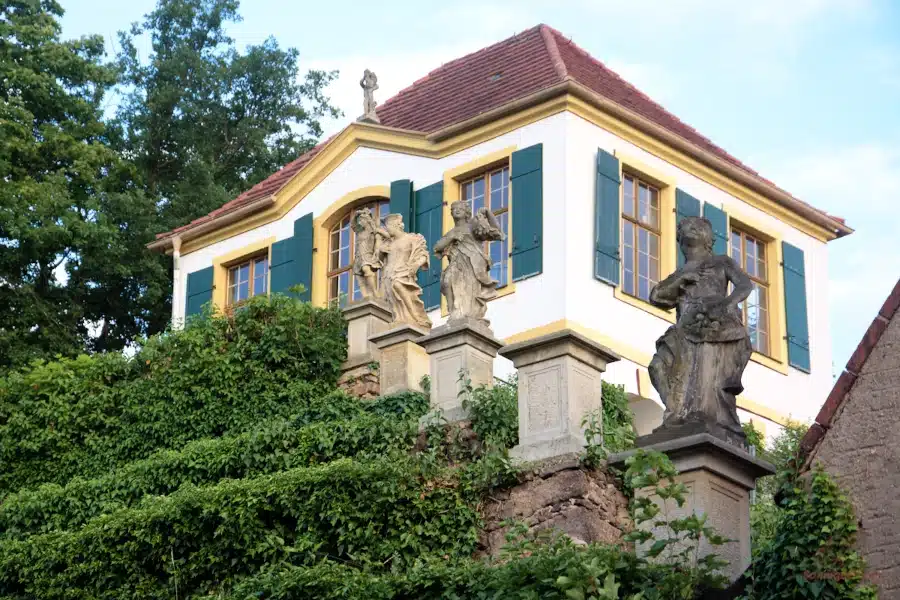
If you are traveling south on the east german Elbe Cycle Way, the Elbe hill country in Saxony begins behind the chemical plant of Nünchritz near Riesa with the ridge of the Leckwitzer Schanze and thus the most beautiful section of the Elbe Cycle Way of all. At least for those who like extensive plains less and love more variety in the landscape. The small village of Diesbar Seuszlitz with its baroque manor house, castle garden and the adjoining nature reserve Seuszlitzer Grund is the entry point, so to speak, to the Elbe Valley of Meißen. There, an idyll between vineyards invites you to a longer rest on the Elbe.
[Contains *advertising]
Diesbar and Seusslitz – two villages on the Elbe River
For the visitor, there is certainly more connecting than separating between Diesbar and Seusslitz, although the two villages on the Elbe were originally independent places. Since 1953, however, both belong together as Diesbar – Seusslitz and are directly connected by a road, the Elbe Cycle Way and the Elbe River. But paths also lead from Seuszlitz to Diesbar and vice versa – as hiking trails or geological exploration paths, on archaeological trails and as the beginning of the Saxon Wine Route, which begins in Seusslitz, leads via Diesbar and Meißen to Dresden and has its southern endpoint in Pirna on the edge of Saxon Switzerland.
Historically, Seusslitz appears to be the more interesting part of town with its baroque manor house, former monastery church, French garden and English landscape park. Gastronomically Diesbar is probably more exciting, since here are several wineries and Elbe riverbank – restaurants. Thus, each of the districts, which are about 1.5 km „stream length“ apart, has its merits.
The baroque castle Seusslitz
In the right Elbe notch valley Seusslitzer Grund lies the pleasing ensemble with the baroque manor house Seusslitz and other buildings, which is definitely worth a stop on any Elbe bike tour.
The area belonged in the 13th century to the Meissen Margrave Heinrich the Illustrious (1215 – 1288), who developed Seuszlitz as a hunting residence. After the early death of his second wife Agnes, after all a daughter of the Bohemian King Wenceslas I, Henry the Illustrious founded the Poor Clares Monastery of Seusslitz in memory of her. The nunnery of St. Afra was opened in 1272. After the Reformation, the convent was dissolved in 1541. The Chancellor of the Electorate of Saxony, Simon Pistorius, acquired the land and rebuilt the complex, so that Seuszlitz was first mentioned as a knight’s estate in 1552. Sesslitz remained in the possession of the Pistorius family until 1720.
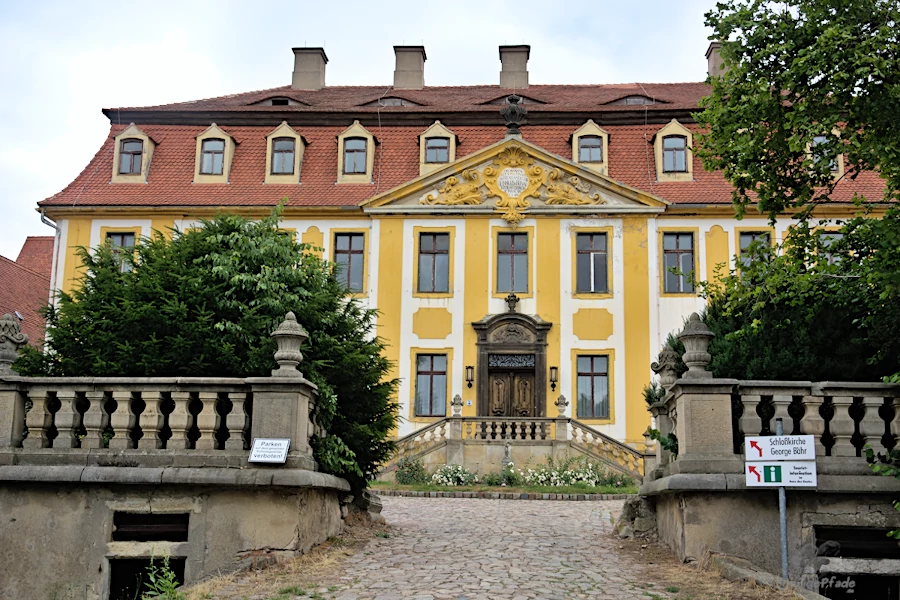
The baroque transformation began after Heinrich von Bünau (1665 – 1745) acquired the manor house in 1722. He was the chancellor Heinrich von Bünau at the court of August the Strong in Saxony. This is important to mention, since the von Bünau family was widely branched in Saxony and, moreover, the male first-borns were usually given the name Heinrich out of a family tradition. In this respect, this Heinrich von Bünau is not identical with the builder of the manor house in Dahlen with the same name.
For the reconstruction of the castle, the church and the park in Seuszlitz, Heinrich von Bünau was able to win a well known architect: George Bähr, who today is most famous as the builder of the Dresden Frauenkirche. Thus, by 1733, a baroque ensemble of buildings was created in Seusslitz, as it can largely still be admired today.
The manor house building
The palace building stands on a terrace quasi like a bar in front of the Seußlitz ground with a view of the Elbe flowing past. An open staircase with baroque sandstone balustrades gives access to the wooden portal. In a coat of arms-like medallion in the triangular gable above the archway, the Lord of Bünau is still noted as the lord of the house.
The Seusslitz palace has two stories, the mansard roof gains structure through a series of dormers.
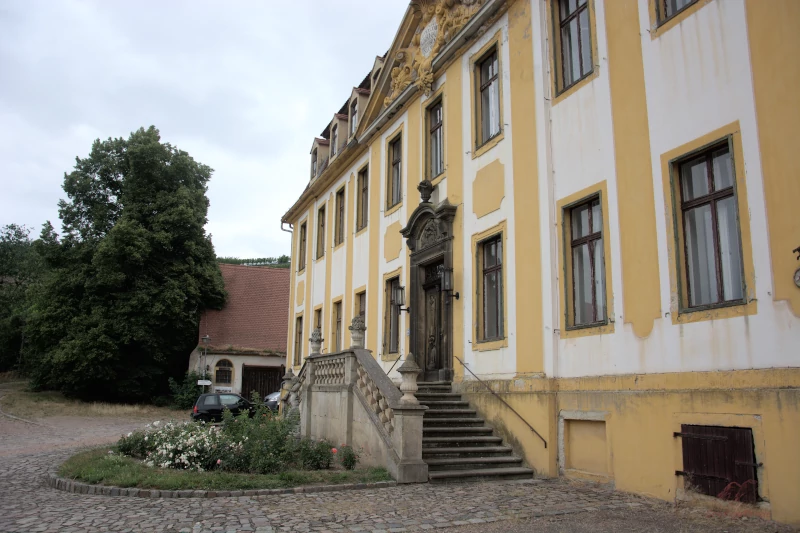
Unfortunately, the castle itself is not accessible today and already shows some signs of decay on closer inspection. The building was used as an old people’s home during the GDR period (socialist east germany) and until the year 2000. Afterwards the „re-privatization“ took place, at an auction a West German new owner acquired the property. Since then the manor house Seusslitz stands unused.
The Seusslitz Castle Church
Two wings were added behind the manor building, enclosing a small courtyard. The castle church, built by George Bähr on the walls of the old Gothic monastery church, is integrated into the south wing. Stylistically, however, it is completely adapted to the Baroque ensemble. Several galleries surround the interior. A marble pulpit altar is the most important eye-catcher in the church interior, behind it is the organ.
The castle church of Seusslitz has five bells, including two whose casting dates back to the time when the monastery was founded in the 13th century. Two bells were cast in 1956 at the Schilling foundry in Apolda, Thuringia.

There are several gravesites in the churchyard, some of which date back to the time of the monastery in the 13th century. The Count of Bünau as well as his wife also found their last resting place in the Seusslitz churchyard.
The visit of the castle church is possible during the day, from 10 a.m. to 5 p.m. (if necessary, limited according to the season). To get to the castle Seusslitz church, you have to walk up the alley to the left of the manor house and pass a narrow passage on the right in front of the Haus des Gastes (house of the Guest). The entrance on the north side can then be reached via the small churchyard.
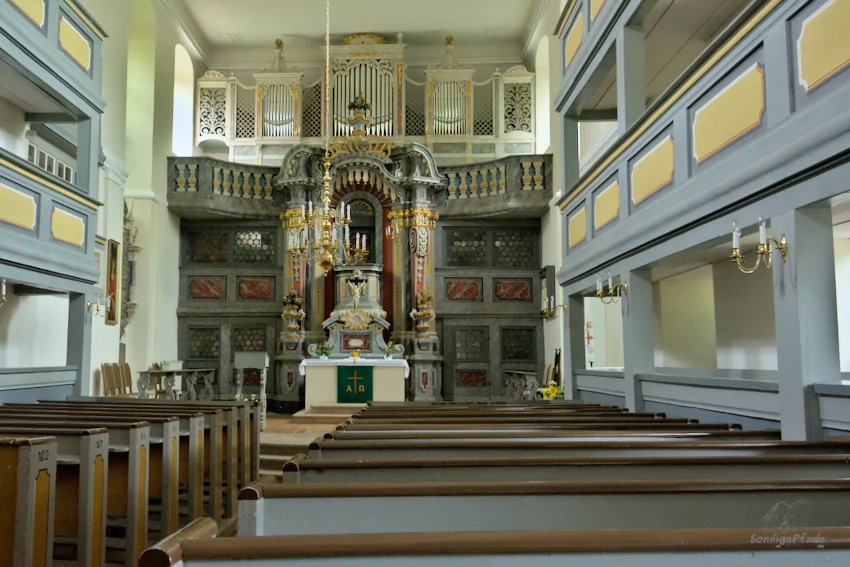
The castle garden of Seusslitz
The castle garden at the baroque manor house of Seusslitz can be visited freely via several entrances. South of the castle church is a French-style baroque garden with a terrace along the front of the building, sandstone sculptures, flower beds and trimmed hedge elements. The sculptures were created by the famous Saxon baroque artist Balthasar Permoser and are supposed to personify the seasonal changes.
To the south, the garden merges into a hill with wine terraces, on the top of which George Bähr had a garden house built – the „Heinrichsburg“.
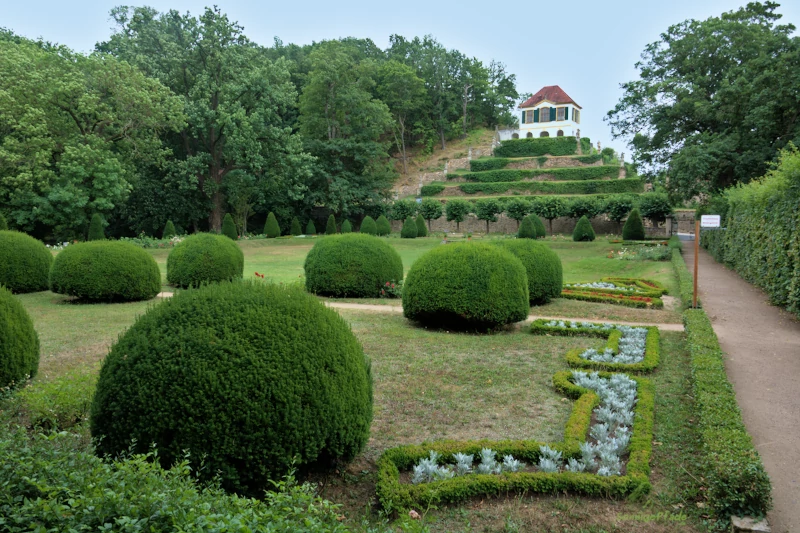
Towards the east and thus following the valley incision, an English landscape park with a small pond and a diverse tree population of various species such as gingko, silver maple, bald cypress, etc. follows.
At the eastern end of the English garden there is a villa with a half-timbered upper floor. This was built by the Leipzig art collector and art historian Fritz von Harck around 1895 for his parents as a residence. The family Julius von Harck had already acquired the castle Seusslitz around 1880 and used it as a family residence. At the end of the 19th century, the villa in the eastern garden of the castle park served as a move-out house, so to speak, for the parental family. After a use as a kindergarten during the GDR – time, the house is today again privatized residential building with rental apartments.
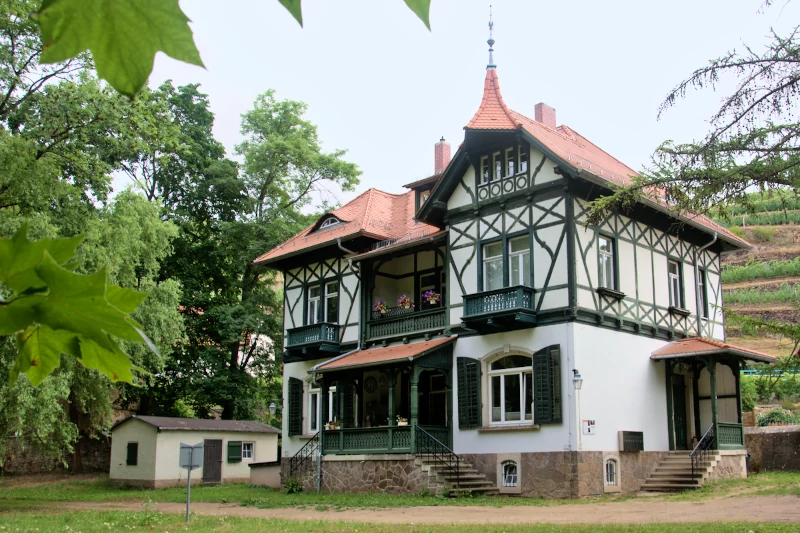
The Luisenschlößchen and Heinrichsburg garden house
As already mentioned, castle Seusslitz forms a sort of crossbar in front of the Seusslitzer Grund, an eastern side valley of the Elbe river. On the slope north of the castle there are wine terraces – and far above a one-story baroque winegrower’s house with a hipped roof: the Luisenschlößchen or Luisenburg. This was built in 1725.
Practically opposite, on a hill at the southern end of the French castle garden, rises, as already mentioned above, the Heinrichsburg. The garden house was also built by George Bähr in 1725/26 as a two-story building, the name comes, as can easily be assumed, from the then lord of the castle, Heinrich von Bünau. From the terrace in front of the Heinrichsburg you can enjoy a wide view of the Elbe valley as well as the view of the garden and the castle church. It is also a stop on one of the hiking trails around Seusslitz. The winegrowers‘ association occasionally uses the Heinrichsburg as an exhibition space today. The exhibition on viticulture, which was current during my visit, can be visited on Sundays from 2 to 5 pm.
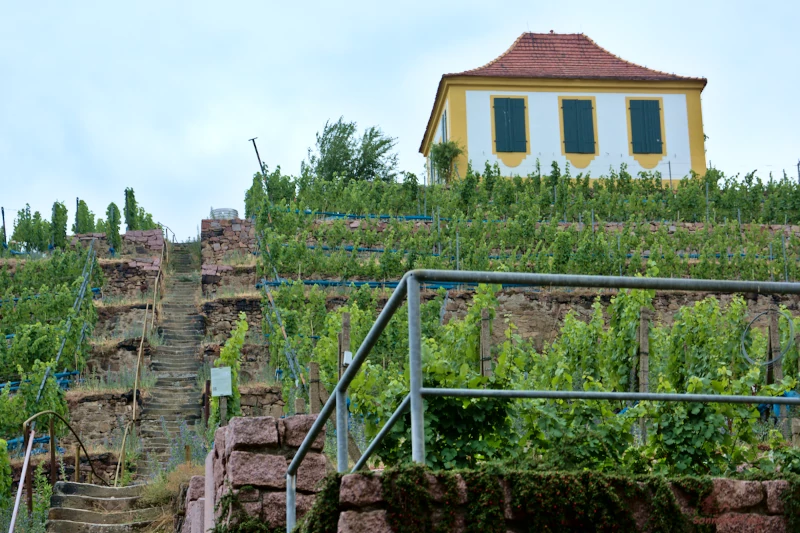
The house of the guest next to the castle Seusslitz
In the building of the wine press from 1819, which belongs to the castle, the ‚house of the guest‘ Diesbar Seusslitz is located since the middle of the 90s. The rooms are used among other things for art exhibitions. During my visit, for example, for painting and graphics on classical materials as well as modern oil on acrylic by regional artists from the Elbe Valley.
Supposedly with the dissolution of the nunnery about 500 years ago because of the „surplus of wedding-ready women“ goes the tradition of the Seußlitz marriage market. For one day, anyone can get married there on Ascension Day. Whether the connection holds later also longer, for it each and everyone is probably responsible.
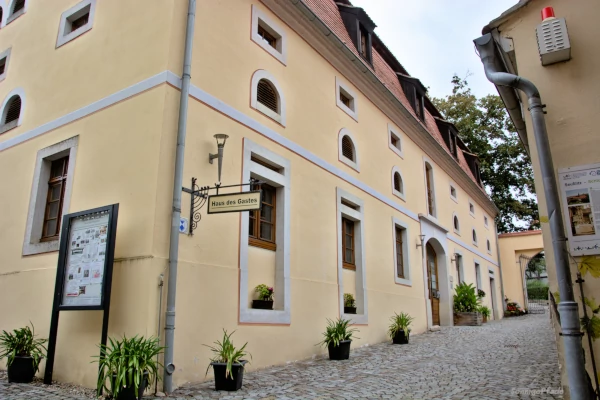
The surroundings of castle Seusslitz
Hiking in the Seußlitzer Grund
If you have longer time, then enjoy the quiet hike through the Seußlitzer Grund! Behind the English castle garden there is a playground with a picnic table and the gondola pond, a dammed up small pond with water from the Seusslitz brook. The nature reserve Seußlitzer Grund is directly adjacent to it. There it becomes quiet and even in summer pleasant under mixed beech forest to explore the loess clay slopes of the Seusslitz valley. If you are lucky, you can even spot the black woodpecker.
There are three recommended hiking trails near Seusslitz with yellow, blue and red signs. The yellow one is with 1.5 km the shortest suggested route via the „Dobschützer Kirchsteig“ (church stairs). This route makes only a small detour through the Seußlitzer Grund.
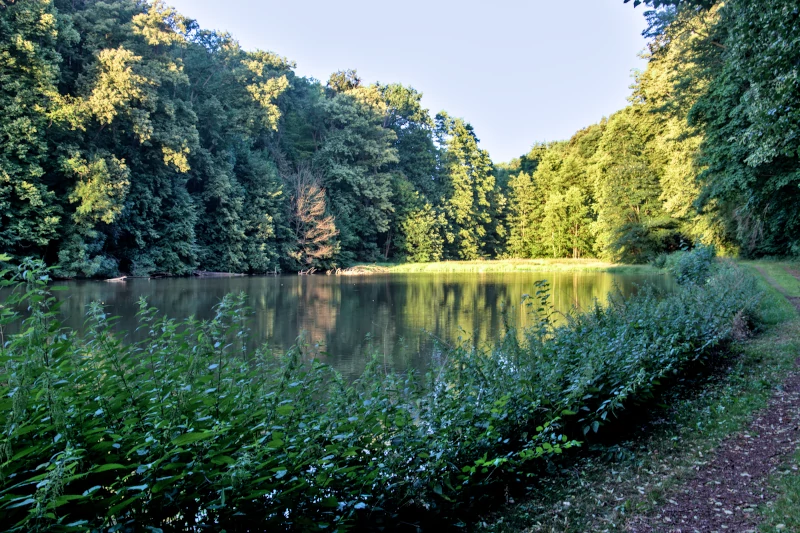
Via the blue path you can walk far through the ground, always along the Seusslitz brook, until the route turns up to the Radewitz estate and reaches an old fortress wall from the Bronze Age at the Goldkuppe (173m). From the Goldkuppe a wide view over the Elbland opens up. The way back is via Heinrichsburg. Length of the trail is about 3km.
The red trail is the longest and leads first along the Elbe riverside to Diesbar. Thus practically a first stage on the Saxon wine route. A wide loop along the vineyards leads uphill to the Radewitz estate. From there the descent to the Seußlitzer Grund takes place. This trail is about 5km long.
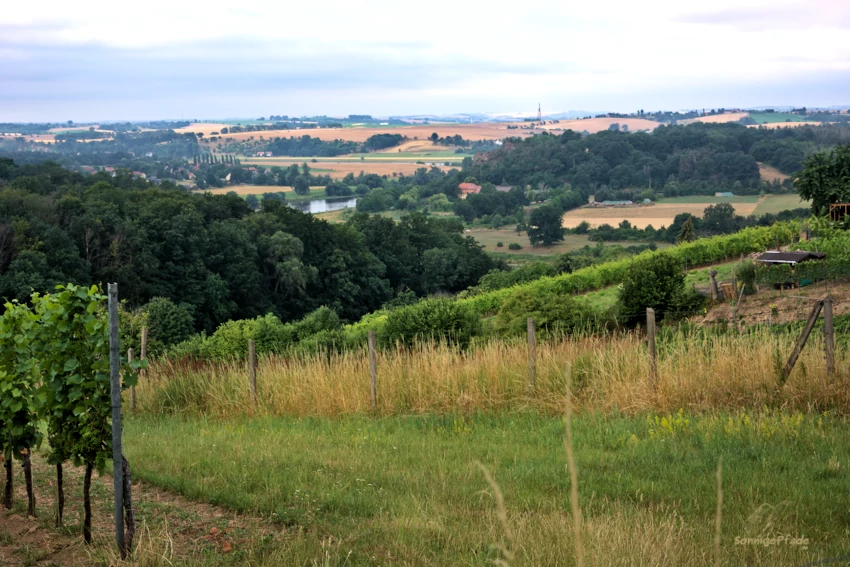
Since all three trails meet on the way, an individual combination is of course also possible or possibly a shortening, if it should be too much. The trails are all easy to master even for the inexperienced, difficulties lie only in short climbs out of the valley (or descents in the opposite direction).
Archaeological hiking trail Diesbar Seusslitz
I didn’t find the archaeological hiking trail with waymarking, but some (unfortunately a little bit weathered) signs show the historical aspect of the region. So if you are interested in history, you can hike to some archaeologically relevant places in the area around Diesbar Seusslitz.
Probably the oldest station is the already mentioned Bronze Age fortress on the Goldkuppe. This must have been an extensive fortification, because the longest rampart is after all 1 km long and at one point in the southeast the rampart still towers up to a height of 18m. There were several settlements in the surrounding area. It is the largest known prehistoric rampart in Saxony. Further ramparts can be found at Löbsal further east and on the opposite bank of the Elbe at the Göhrisch estate.
Near Diesbar was the Rauhe Furt (Rough ford). This was an early possibility to cross the Elbe. The name Rauhe Furt indicates that it was probably not so easy to cross this way. There were several fords in the region, which were used by long-distance trade with Eastern Europe. Customs duties were also levied. At the Rauhe Furt some traders probably tried to avoid the payments and took a greater risk in crossing the river. A castle complex on the rock on the left bank of the Elbe near the Göhrisch estate also served to monitor the passage of the Elbe.
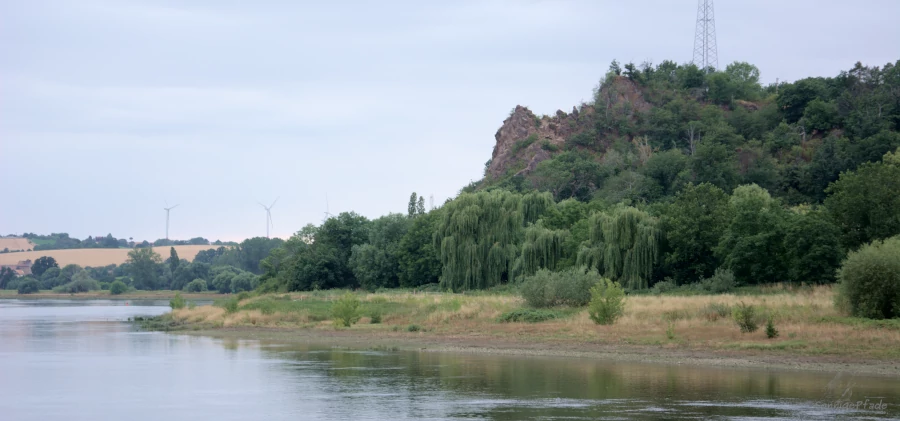
The Evil Brother
Between Diesbar and Seusslitz lies a mountain, which is only partly covered with vineyards. On top of it is the Goldkuppe, which has already been mentioned several times. Towards the Elbe, the rocky walls are cut off – they were worked as a quarry until the 1970s. There used to be a rock formation there that resembled a face – called the Evil Brother. According to legend, two brothers were in love with the same girl. But the maiden could love only one and spurned the other. The spurned lover threw his brother off the cliff and turned to stone in the face of his misdeed.
Already in the 1930s, however, the rock face was blown up with the progressive quarrying of stone.
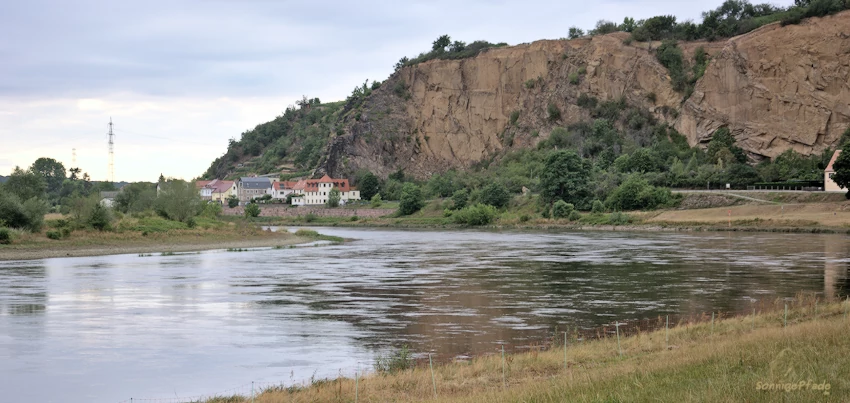
Wineries in Seusslitz and Diesbar
As already mentioned, the Saxon Wine Route begins in Seußlitz. In addition, almost every small slope along the Elbe Valley is used for wine growing. This includes the slopes to the right and left of castle Seusslitz with the Luisenschlößchen and Heinrichsburg. One of the farm buildings belonging to the castle Seusslitz is now the „Wine Kingdom“. Also on the road in the direction of Diesbar there is still a winery Lehmann.
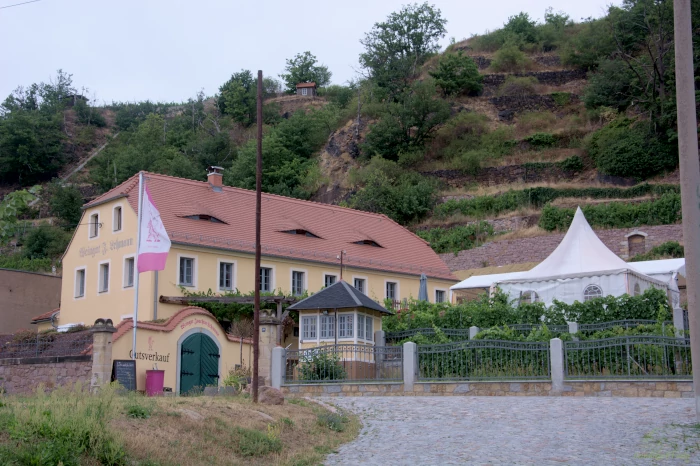

In Diesbar itself, the winery Jan Ulrich is the top dog, so to speak. There you can also sit on a terrace and watch the lazily flowing Elbe with a wine glass in your hand.
In front of the winery there is an old wooden wine press from 1842, a „double spindle press underneath“, with which 3 tons of wine could be pressed at once. Thick oak posts were used for the then state-of-the-art device. The spindles themselves are made of apple wood.
If you would like to combine Saxon Elbe Valley wines with Italian culinary delights, you will find a trattoria in one of the outbuildings at castle Seusslitz. After all, not everyone likes the culinary standards of Saxon cuisine.
Elbe flood 2002
August 2022 marked the 20th anniversary of the Elbe flood of 2002. It is considered the „flood of the century,“ although another flood of similar magnitude hit the Elbe and Mulde river regions in 2013. At least on the Elbe, however, the damage was significantly less because the dikes had been extended in the meantime.
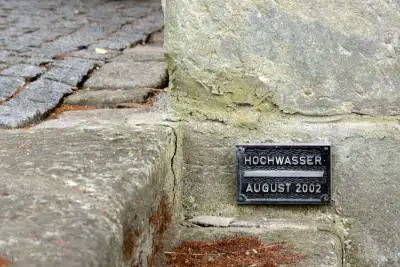
In the region, flood marks can be found everywhere on houses and walls. A good opportunity to compare for yourself, as marks from previous floods can also be discovered. And to imagine how far the floods reached in the area – because often you stand in front of the high water marks and look up!
Near Diesbar Seusslitz the highest level of the Elbe was measured on August 17, 2002 with 9.40 meters. Until then, the highest level from the year 1845 was 8.45 m – almost one meter less.
How do you get to Diesbar Seusslitz?
The next airport to the Elbe river valley is Dresden airport. There you can get full service like public transport or rental car service.
By bicycle on the Elbe cycle way
The most beautiful way to get there is by bicycle on the Elbe Cycle Way. Diesbar Seusslitz is located on the right side of the Elbe river in the section between Meißen and Riesa. In Meißen and Riesa are also the nearest Elbe bridges. If you are traveling on the left bank of the Elbe, you can take the ferry to Seusslitz in Niederlommatzsch (pedestrians and cyclists only).
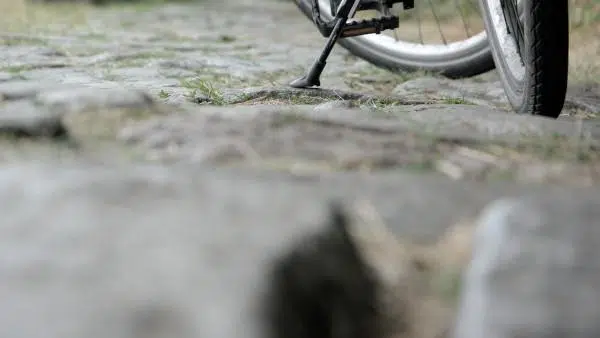
If you come from Riesa, you will pass the old towpath at Leckwitz. Don’t worry, this quarry stone paved section is only about 120m long, but historic. On the so-called Leinpfad (towpath), merchant ships heading upstream from the Elbe were pulled against the current by the „Bommätzschers“ on ropes. Also interesting to see is an old tower crane in Merschwitz, which was used to lift the rafted logs for a sawmill.
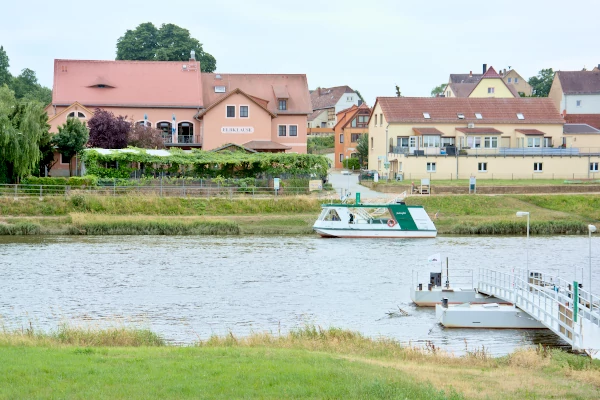
By car through Saxon country
If you are traveling by car, rental car* or motor home*, you can use the S 88 northbound from Meißen on the right bank of the Elbe, which also connects Diesbar and Seusslitz along the Elbe. The approach to Meißen is possible via the freeway A 4 (Erfurt – Dresden) or A14 (Leipzig – Dresden). From Leipzig, the scenic old F6 (now B6) to Dresden is also recommended. Car renting stations are at the Leipzig Airport and Dresden Airport.

In Seusslitz, a visitors‘ parking lot has been set up on the Elbe meadows. In the rear part towards the Elbe is space for motor homes. For users of electric cars there is a charging station with two charging places.
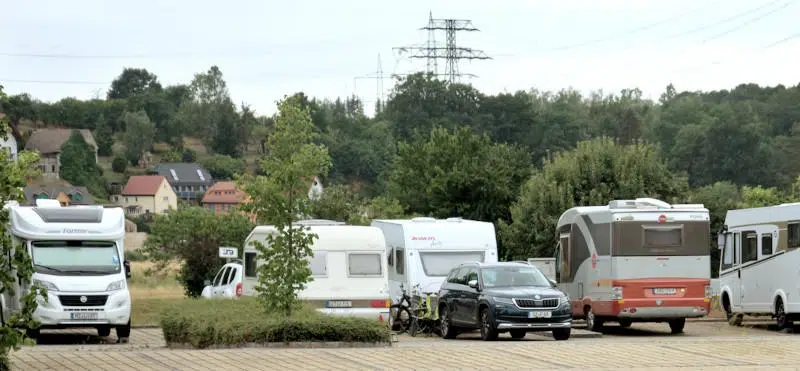
On the Elbe river with a paddle wheel steamboat of the White Fleet
There is a steamboat – line „Saxon Wine Route“ of the Dresden White Fleet on the Elbe. The northernmost station is Seußlitz. This way, steamboat romance can be combined with a visit to the baroque garden and winery.
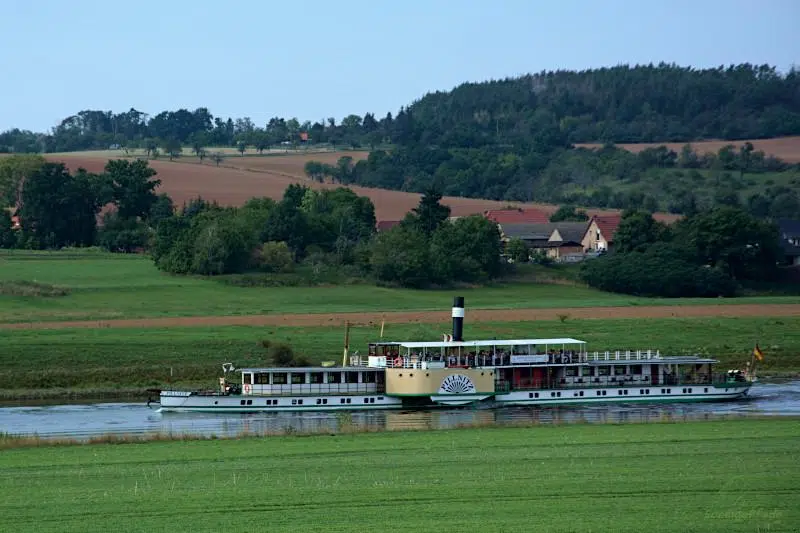
Accommodation in Diesbar Seusslitz and surroundings
In order to enjoy the interesting castle complex, the baroque garden and the Elbe valley landscape in and around Diesbar Seusslitz, a stay of two or three days is recommended. Even in autumn or winter the area has its charm and a hike through the Seußlitzer Grund is possible even if snow covers the paths – steep stairs are not to be feared here. In the season from Easter to October it is of course advantageous that exhibitions and events, e.g. in the castle church or in the Haus des Gastes, offer a cultural framework. The city of Meißen with its porcelain manufactory and Albrechtsburg Castle is not too far away (10 km).
A vacation apartment in the countryside* for two adults can be found in Neuseußlitz on the road to Merschwitz. This well-equipped accommodation with a view of Hirschstein Castle on the opposite bank of the Elbe is on the ground floor, making it suitable for guests with limited mobility.
The winery Jan Ulrich* in Diesbar offers not only exquisite Elbtal – wines, but also vacation rooms, apartments and a vacation apartment in different sizes from the single accommodation to the 4 – guest – apartment with two bedrooms. From the terrace or balcony you can look at the vineyards or the Elbe. Bicycle storage facilities are available, so that cyclists on the Elbe Cycle Way can also take an overnight break at the Ulrich Winery.
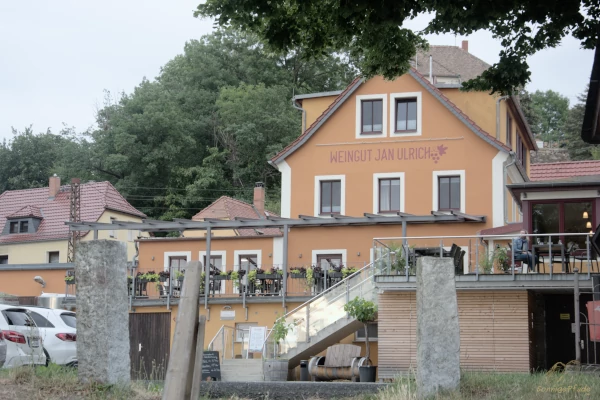
The Jägerheim Löbsal* is one of the better known inns in the area of Diesbar Seusslitz, but also offers several rooms and vacation apartments for its guests. If you are not traveling by car, you can walk to Löbsal even from Diesbar via the „school path“ through the southern part of the Grund Protected Area. Towards the Elbe River there are several viewpoints that can be explored during a forest hike. The hunter’s lodge Löbsal is located at the village square. Bicycles can be rented free of charge at the Jägerheim. Your own bicycles can be safely parked in the garage. Dogs and other pets may be subject to a one-time fee.
Also in Löbsal is the vacation apartment Serpina* with space for 3 guests in the bedroom. Using the sofa beds in the living area, the capacity can be increased up to 7 overnight guests. This apartment offers a terrace, shared use of the garden and an outdoor pool. Since the apartment is located on the ground floor, the accommodation is suitable for guests with limited mobility, including wheelchair users if necessary.
Would you like to go on an Elbe tour with friends?
Then it would be nice if you share the link to the post on your social media channels! A positive echo for good posts helps search engines to separate the wheat from the chaff and deliver better results – and to inspire your circle of acquaintances for the Elbe Valley 🙂 Thanks!
Note on *advertising links
In this post, individual links are marked with *. These links lead to online – stores or agencies. If you buy or order something there, the sunny trails blog receives a small commission to cover the technical expenses. Nothing will be more expensive for you, because the providers already include commissions in the pricing.

